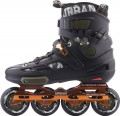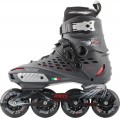Size
—
Fixed size. Boots of the simplest design, having one size and not allowing for adjustment in length. In addition to the obvious disadvantage of the impossibility of adjusting to size, this design also has an advantage - it is considered more durable and reliable than an adjustable one, and if selected correctly, it sits “firmer” on the foot, which makes such boots more suitable for performing various tricks. In general, rollers with a fixed size are suitable either for an adult user whose leg is no longer growing, or for a child, if we are talking about a pair for one season.
—
Adjustable size. Boots that allow you to adjust the size within a certain range - usually within 3 - 5 sizes, for example 36 - 39 or 28 - 32. The advantages of this option are obvious: it allows you to optimally adjust the boot to your foot size, one pair of rollers can be used in turn by different people, and for rollers bought for a growing child, the adjustable size is simply a salvation: without this, the rollers would have to be changed every year. On the other hand, adjustment complicates the design of the boot and reduces its strength, so this design is not widespread in professional models (“aggressive”, running, etc.).
The size itself is given according to standard shoe sizes. At the same time, the listing of sizes - for example, “
39,
40..., 41 ” - means that the rollers are available in several modifications with a fixed size; and a hyphenated record like “39 – 41” corresponds to one shoe with an adjustable size.
Note that formal compliance with the foot size does not necessarily mean that the rollers will suit a particular user. Firstly, human legs have individual shapes, and a model that is normal in length may, for example, turn out to be cramped in the instep. Secondly, some manufacturers can be quite liberal with sizes, especially when it comes to budget models. Therefore, when choosing, it is recommended not to rely on the stated figures, but to check the comfort of the boot “live” (or at least clarify how the stated dimensions correspond to the actual ones), especially for children’s skates.
Currently the following roller sizes are available on the market: 25, 26, 27, 28, 29, 30, 31, 32, 33, 34, 35, 36, 37, 38, 39, 40, 41, 42, 43, 44, 45, 46, 47.Wheel stiffness
Stiffness of wheels supplied with roller skates.
The higher the number given in this parameter, the harder materials are used in the construction of the wheels and the stiffer they are. Stiffer wheels better roll on different surfaces, it is easier to accelerate on them, they allow you to more accurately feel the surface under your feet and do not wear out as quickly as soft ones. On the other hand, these wheels have less grip, are more prone to vibrations and bumps, and require extra care when cornering. Therefore, wheels with high stiffness (
83A and above) are typical mainly for professional models, and soft options are recommended for beginner skaters.
Note that most modern roller skates allow the replacement of wheels; this procedure is mandatory from time to time since the wheels tend to wear out. However, if necessary, you can also change a kit that is quite suitable for riding — for a harder one, or vice versa, a softer one.
At the same time, an experienced person buying new roller skates can pre-select the desired wheel stiffness among those on the market:
78A,
80A,
81A,
82A,
83A,
84A,
85A,
86A,
88A,
90A..., 94ABearing
Class of bearings installed in roller skates.
There are several standards by which this parameter can be designated. The most popular is ABEC (Annular Bearing Engineering Committee), and the ILQ (InLine Qualified) designation is also common. In both cases, the bearing class is expressed by a number after the abbreviation:
ABEC 1,
ABEC 3,
ABEC 5,
ABEC 7,
ABEC 9 or
ILQ 5,
ILQ 7,
ILQ 9. The higher this figure, the higher the accuracy with which the bearing is made, and the higher the quality (and, accordingly, the more expensive it is). The meaning of specific numbers in both standards is the same. So, class 1 and 3 bearings are typical mainly for entry-level children models, and they are used not so much to reduce cost, but because it simply does not make sense to install better parts in such rollers. Class 5 is considered quite sufficient for mid-level fitness roller skates and inexpensive stunt models (see "Riding style"), and higher values are typical mainly for professional equipment.
We note that the class of bearings is not related to their speed characteristics — it is only about the overall build quality. But this parameter noticeably affects the service life: precise fitting of
...parts helps to reduce their wear and increase the durability of bearings.
